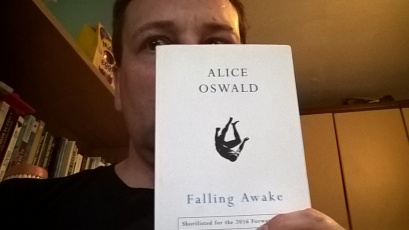Learning to Read #9

I’m not a big fan of poetry that plays with the layout a lot; word art and lines that go up and down, or round. I’m a bear of simple brain, and it makes me mutter under my breath about sixth form trying to be clever for the sake of being clever, what’s wrong with a proper poem, nice lines on a clean bit of white paper and so on. I blame it on some unfortunate incidents in the 80’s.
I was suspicious, therefore, when I opened up this book and saw that the second half is all spread out, with big empty gaps and what looks like a periodic time running down each page. One double page spread consists of a single word. I decided to play safe, defy convention at this point, and start at the start. The opening poem is “A Short Story of Falling” and it is a beautiful thing. “It is the story of the falling rain / to turn to leaf and fall again // it is the secret of a summer shower / to steal the light and hide it in a flower” It is a poem of rhyming couplets, with a great delicacy and imagination and, basically, describes the water cycle. It plays around the overlap of science and poetry and this is a good place to be, in my opinion. Later, you have Flies “This is the day the flies fall awake mid-sentence / and lie stunned on the window-sill shaking with speeches / only it isn’t speech it is trembling sections of puzzlement which / break off suddenly as if the questioner had been shot” There is a lot about nature in this book, again in Fox and Swan, which are the other two that make up the first four pieces. All of them take a slightly slanted but striking view, with some electrifying images that burn into your head. “It’s midnight / and my life / is laid beneath my children / like gold leaf“. The inner sleeve tells you that these poems are “to be read aloud” and talks of “language as it’s spoken” and this feels right.
Apart from a couple of them, such as Severed Head Floating Downriver, where my mental block about formatting re-appeared.
I think that my dislike of word art style poetry is down to my preference for poetry as a spoken art form rather than one which is visual. I read the words in my head as I scan across them on the page. Even from a book, it’s a mini performance for me. I understand how a poem can become a more visual piece through placement and structure – another blog here, by Jo Bell, a much more informed voice than mine, touches on the artistic merits of how a poem looks – but my preference is on how it sounds, and I find that chasing the words around the page detracts from this for me.
Which brings me to the second half of this collection. The timeline and the structure here are exactly that – an imposed representation of the passage of time. The poem is a long piece based on the story of Tithonus and it is intended to describe the passage of exactly 46 minutes. The structure used here is intended to stretch the poem, to give it the feeling of time passing, and it does do this. It pauses. It reflects. It waits. One aspect of the story is the desire for closure, and the awareness that it will never come. The format of the poem gives you this. I was surprised, in all honesty, that I bought into this. Clearly, it didn’t take me 46 minutes to read it, but I felt genuinely drawn into this temporal sleight of hand. The imagery is as strong as the earlier poems, but I was given something else, to compliment this, purely from the page layout.
You don’t need me to tell you this, but this is one heck of a talented poet here. And this is a very accomplished collection of poems. Go read.